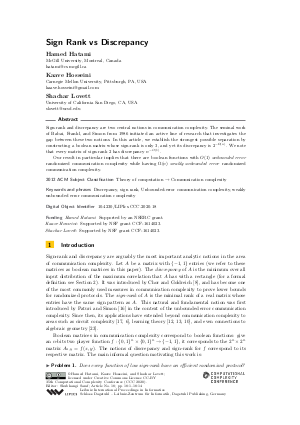Sign Rank vs Discrepancy
Authors Hamed Hatami, Kaave Hosseini, Shachar Lovett
-
Part of:
Volume:
35th Computational Complexity Conference (CCC 2020)
Part of: Series: Leibniz International Proceedings in Informatics (LIPIcs)
Part of: Conference: Computational Complexity Conference (CCC) - License:
 Creative Commons Attribution 3.0 Unported license
Creative Commons Attribution 3.0 Unported license
- Publication Date: 2020-07-17
File

PDF
LIPIcs.CCC.2020.18.pdf
- Filesize: 0.51 MB
- 14 pages
Document Identifiers
Subject Classification
ACM Subject Classification
- Theory of computation → Communication complexity
Keywords
- Discrepancy
- sign rank
- Unbounded-error communication complexity
- weakly unbounded error communication complexity
Metrics
- Access Statistics
-
Total Accesses (updated on a weekly basis)
0PDF Downloads0Metadata Views
Abstract
Sign-rank and discrepancy are two central notions in communication complexity. The seminal work of Babai, Frankl, and Simon from 1986 initiated an active line of research that investigates the gap between these two notions. In this article, we establish the strongest possible separation by constructing a boolean matrix whose sign-rank is only 3, and yet its discrepancy is 2^{-Ω(n)}. We note that every matrix of sign-rank 2 has discrepancy n^{-O(1)}.
Our result in particular implies that there are boolean functions with O(1) unbounded error randomized communication complexity while having Ω(n) weakly unbounded error randomized communication complexity.
Cite As Get BibTex
Hamed Hatami, Kaave Hosseini, and Shachar Lovett. Sign Rank vs Discrepancy. In 35th Computational Complexity Conference (CCC 2020). Leibniz International Proceedings in Informatics (LIPIcs), Volume 169, pp. 18:1-18:14, Schloss Dagstuhl – Leibniz-Zentrum für Informatik (2020)
https://doi.org/10.4230/LIPIcs.CCC.2020.18
BibTex
@InProceedings{hatami_et_al:LIPIcs.CCC.2020.18,
author = {Hatami, Hamed and Hosseini, Kaave and Lovett, Shachar},
title = {{Sign Rank vs Discrepancy}},
booktitle = {35th Computational Complexity Conference (CCC 2020)},
pages = {18:1--18:14},
series = {Leibniz International Proceedings in Informatics (LIPIcs)},
ISBN = {978-3-95977-156-6},
ISSN = {1868-8969},
year = {2020},
volume = {169},
editor = {Saraf, Shubhangi},
publisher = {Schloss Dagstuhl -- Leibniz-Zentrum f{\"u}r Informatik},
address = {Dagstuhl, Germany},
URL = {https://drops.dagstuhl.de/entities/document/10.4230/LIPIcs.CCC.2020.18},
URN = {urn:nbn:de:0030-drops-125700},
doi = {10.4230/LIPIcs.CCC.2020.18},
annote = {Keywords: Discrepancy, sign rank, Unbounded-error communication complexity, weakly unbounded error communication complexity}
}
Author Details
Funding
- Hatami, Hamed: Supported by an NSERC grant.
- Hosseini, Kaave: Supported by NSF grant CCF-1614023.
- Lovett, Shachar: Supported by NSF grant CCF-1614023.
References
-
Noga Alon, Shay Moran, and Amir Yehudayoff. Sign rank versus vc dimension. In Conference on Learning Theory, pages 47-80, 2016.

-
László Babai, Peter Frankl, and Janos Simon. Complexity classes in communication complexity theory. In 27th Annual Symposium on Foundations of Computer Science (sfcs 1986), pages 337-347. IEEE, 1986.

-
Ronen Basri, Pedro F Felzenszwalb, Ross B Girshick, David W Jacobs, and Caroline J Klivans. Visibility constraints on features of 3d objects. In 2009 IEEE Conference on Computer Vision and Pattern Recognition, pages 1231-1238. IEEE, 2009.

- Amey Bhangale and Swastik Kopparty. The complexity of computing the minimum rank of a sign pattern matrix. arXiv preprint, 2015. URL: http://arxiv.org/abs/1503.04486.
-
Harry Buhrman, Nikolay Vereshchagin, and Ronald de Wolf. On computation and communication with small bias. In Twenty-Second Annual IEEE Conference on Computational Complexity (CCC'07), pages 24-32. IEEE, 2007.

-
Mark Bun and Justin Thaler. Improved bounds on the sign-rank of AC⁰. In 43rd International Colloquium on Automata, Languages, and Programming, volume 55 of LIPIcs. Leibniz Int. Proc. Inform., pages Art. No. 37, 14. Schloss Dagstuhl. Leibniz-Zent. Inform., Wadern, 2016.

-
Arkadev Chattopadhyay and Toniann Pitassi. The story of set disjointness. ACM SIGACT News, 41(3):59-85, 2010.

-
Benny Chor and Oded Goldreich. Unbiased bits from sources of weak randomness and probabilistic communication complexity. SIAM Journal on Computing, 17(2):230-261, 1988.

-
Hartmut Klauck. Lower bounds for quantum communication complexity. In Proceedings 2001 IEEE International Conference on Cluster Computing, pages 288-297. IEEE, 2001.

- Adam R. Klivans and Rocco A. Servedio. Learning DNF in time 2^O(n^1/3). J. Comput. System Sci., 68(2):303-318, 2004. URL: https://doi.org/10.1016/j.jcss.2003.07.007.
-
Troy Lee and Adi Shraibman. An approximation algorithm for approximation rank. In 2009 24th Annual IEEE Conference on Computational Complexity, pages 351-357. IEEE, 2009.

- Nati Linial, Shahar Mendelson, Gideon Schechtman, and Adi Shraibman. Complexity measures of sign matrices. Combinatorica, 27(4):439-463, 2007. URL: https://doi.org/10.1007/s00493-007-2160-5.
- Nati Linial and Adi Shraibman. Learning complexity vs. communication complexity. Combin. Probab. Comput., 18(1-2):227-245, 2009. URL: https://doi.org/10.1017/S0963548308009656.
-
Nati Linial and Adi Shraibman. Lower bounds in communication complexity based on factorization norms. Random Structures &Algorithms, 34(3):368-394, 2009.

-
Noam Nisan. The communication complexity of threshold gates. Combinatorics, Paul Erdos is Eighty, 1:301-315, 1993.

-
Ramamohan Paturi and Janos Simon. Probabilistic communication complexity. Journal of Computer and System Sciences, 33(1):106-123, 1986.

- Alexander A. Razborov and Alexander A. Sherstov. The sign-rank of AC⁰. SIAM J. Comput., 39(5):1833-1855, 2010. URL: https://doi.org/10.1137/080744037.
-
Alexander A Sherstov. Halfspace matrices. Computational Complexity, 17(2):149-178, 2008.

-
Alexander A Sherstov. The pattern matrix method. SIAM Journal on Computing, 40(6):1969-2000, 2011.

-
Alexander A Sherstov. Optimal bounds for sign-representing the intersection of two halfspaces by polynomials. Combinatorica, 33(1):73-96, 2013.

- Alexander A. Sherstov. The hardest halfspace. CoRR, abs/1902.01765, 2019. URL: http://arxiv.org/abs/1902.01765.
-
Justin Thaler. Lower bounds for the approximate degree of block-composed functions. In 43rd International Colloquium on Automata, Languages, and Programming (ICALP 2016). Schloss Dagstuhl-Leibniz-Zentrum fuer Informatik, 2016.

- Hugh E. Warren. Lower bounds for approximation by nonlinear manifolds. Trans. Amer. Math. Soc., 133:167-178, 1968. URL: https://doi.org/10.2307/1994937.
